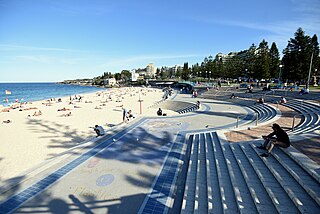
Coogee is a beachside suburb in the Eastern Suburbs of Sydney, New South Wales, Australia, eight kilometres south-east of the Sydney central business district.
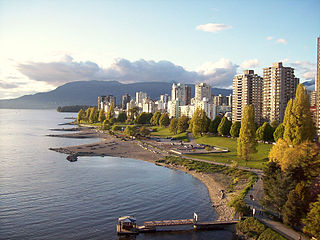
English Bay is an open bay northwest of the Burrard Peninsula in British Columbia, Canada, extending from the headland between Siwash Rock and Prospect Point on Vancouver's Downtown peninsula in the northeast, to the northwestern tip of Point Grey in the southwest. The bay encompasses the coasts of Stanley Park, the West End, Kitsilano, West Point Grey and the University Endowment Lands, and makes up the southeastern portion of the outer Burrard Inlet. There is a narrow inlet named False Creek at its eastern end.
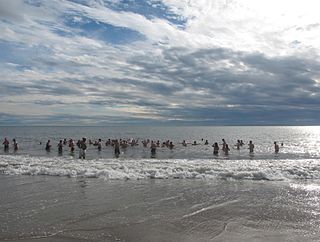
The Coney Island Polar Bear Club is the oldest winter bathing organization in the United States, whose members regularly take polar bear plunges in the winters. The club was founded by famed health advocate Bernarr McFadden in 1903.
The Boxing Day Dip is a charity event where many of the swimmers are in fancy dress swim in the sea on Boxing Day. There are several such dips held around Europe, but the largest is organised by the Red sky Foundation and Lions Club of Sunderland, England. Participants are expected to wear fancy dress and jump into the North Sea..
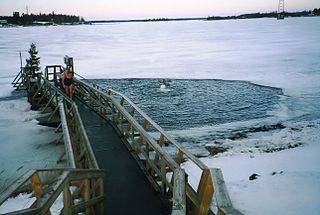
Winter swimming is the activity of swimming during the winter season, typically in outdoor locations or in unheated pools or lidos. In colder countries, it may be synonymous with ice swimming, when the water is frozen over. This requires either breaking the ice or entering where a spring prevents the formation of ice. It may also be simulated by a pool of water at 0 °C (32 °F), the temperature at which water freezes.

Nude recreation consists of recreational activities which some people engage in while nude. Historically, the ancient Olympic Games were nude events. There remain some societies in Africa, Oceania, and South America that continue to engage in everyday public activities—including sports—without clothes, while in most of the world nude activities take place in either private spaces or separate clothing optional areas in public spaces. Occasional events, such as nude bike rides, may occur in public areas where nudity is not otherwise allowed.

Sandy Point State Park is a public recreation area on Chesapeake Bay, located at the western end of the Chesapeake Bay Bridge in Anne Arundel County, Maryland. The state park is known for the popularity of its swimming beach, with annual attendance exceeding one million visitors. The park grounds include the Sandy Point Farmhouse, which is listed on the National Register of Historic Places. The historic Sandy Point Shoal Lighthouse stands in about five feet of water some 1,000 yards (910 m) east of the park's beach.

Mireia Belmonte García is a Spanish Olympic, world, and European champion swimmer. She is the former world record holder in the short course 200 metre butterfly, 400 metre individual medley, 400 metre freestyle, 800 metre freestyle, and 1500 metre freestyle. She was the first Spanish woman to win a gold medal in swimming at an Olympic Games and is widely considered to be the greatest Spanish swimmer of all time.

Sarah Fredrika Sjöström is a Swedish competitive swimmer specialising in the sprint freestyle and butterfly events and one of the most decorated swimmers of all time.

Melissa Franklin Johnson is an American former competitive swimmer and five-time Olympic gold medalist. She held the world record in the 200-meter backstroke from 2012 to 2019. As a member of the U.S. national swim team, she also held the world records in the 4×100-meter medley relay.

Gustave Adolph "Gus" Brickner was a famous swimmer hailing from Charleroi, Pennsylvania in the United States. Born Feb. 10, 1912 to Gustave Adolph Brickner Sr. and Philamena "Minnie" Buchrop. One of Five siblings, Gus's father died at age 29 when Gus was 6 years old. Minnie later married Samuel French.

Farida Hisham Osman is an Egyptian competitive swimmer who specializes in butterfly and freestyle events. She is an All-Africa Games gold medalist and Egyptian national champion and record-holder. Osman is the fastest female swimmer in Egypt and Africa, she is currently coached by Teri McKeever. Osman holds the senior national records for all the butterfly, freestyle and backstroke events, as well as African records in the 50m and 100m butterfly.

The plunge for distance is a diving event that enjoyed its greatest popularity in the 19th and early part of the 20th century, even being included as an official event in the 1904 Summer Olympics. By the 1920s, it began to lose its popularity and slowly disappeared from U.S. and English swim competitions.

Ryan Fitzgerald Murphy is an American competitive swimmer specializing in backstroke. He is a five-time Olympic gold medalist and the former world-record holder in the men's 100-meter backstroke.

Matthews Beach Park is a 22-acre (0.9 km2) park in the Matthews Beach neighborhood of Seattle, Washington. It is a popular swimming beach in the summer, although it is also open during winter months.
The World Triathlon Championship Series is an annual series of triathlon events organised by World Triathlon. The series is used to crown an annual world champion since 2008. Previously, the ITU world champion between 1989 and 2008 had been decided in a single annual championship race.
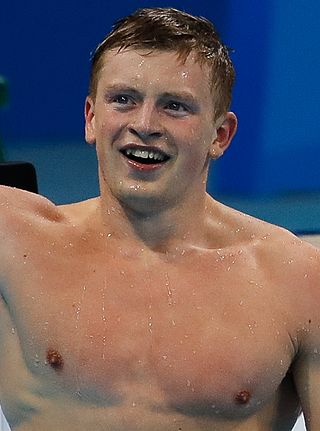
Adam George Peaty is an English competitive swimmer who specialises in the sprint breaststroke events. He won the gold medal in the 100 metre breaststroke at the 2016 Summer Olympics, the first by a male British swimmer in 24 years, and retained the title at the 2020 Summer Olympics in 2021, the first British swimmer ever to retain an Olympic title.

The L Street Brownies are a polar bear club based in South Boston, Massachusetts. Organized in 1902, it is one of the oldest such clubs in the United States. Although the Brownies swim year round, they are best known for their annual New Year's Day plunge in Dorchester Bay.

Human Access Project (HAP) is an organization based in Portland, Oregon, whose mission is "transforming Portland's relationship with the Willamette River". The organization's vision is a city in love with its river. HAP was founded by Willie Levenson, whose official title is the organization's Ringleader, is a tireless and effective advocate for swimming in the Willamette River he brings his love of water to his work as an activist for recreational access to the Willamette River in Portland.





















